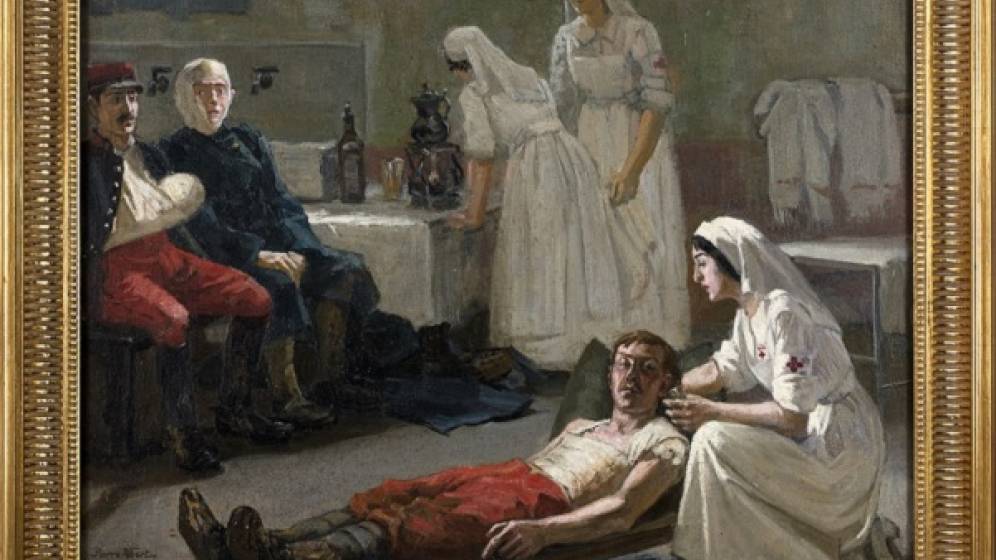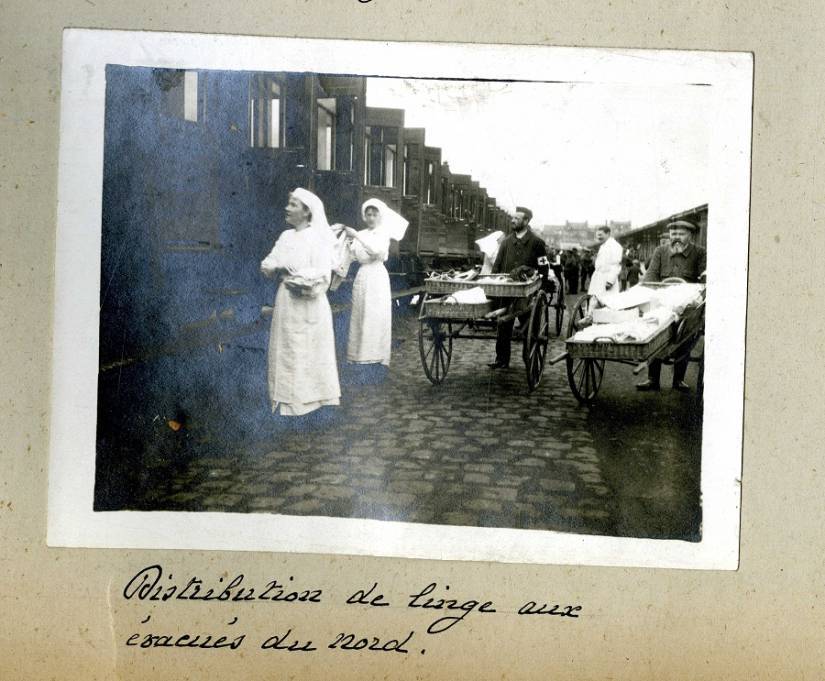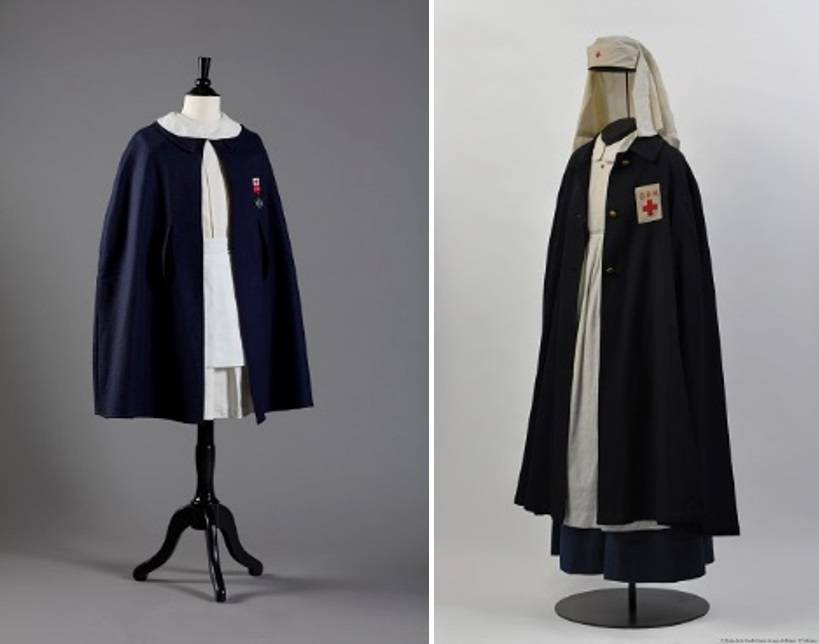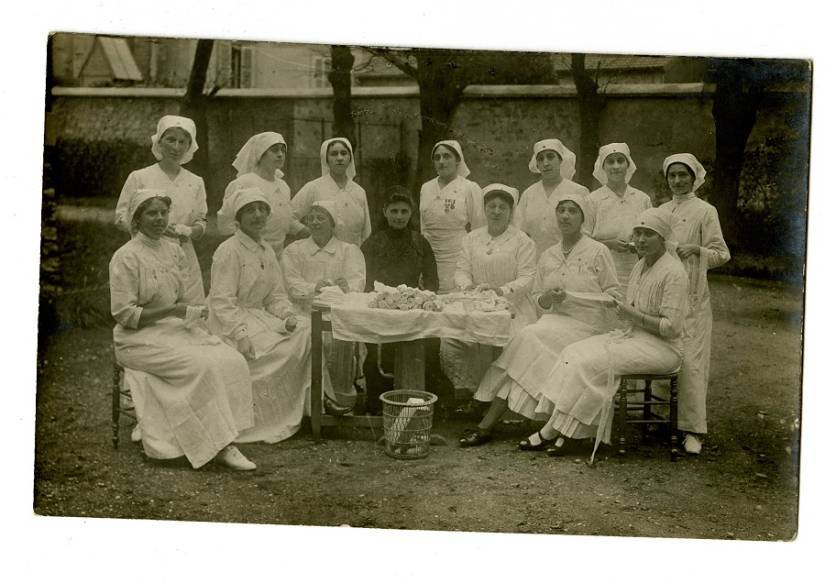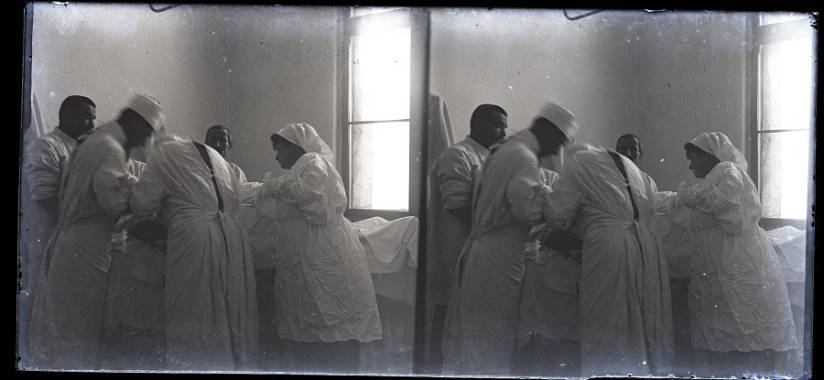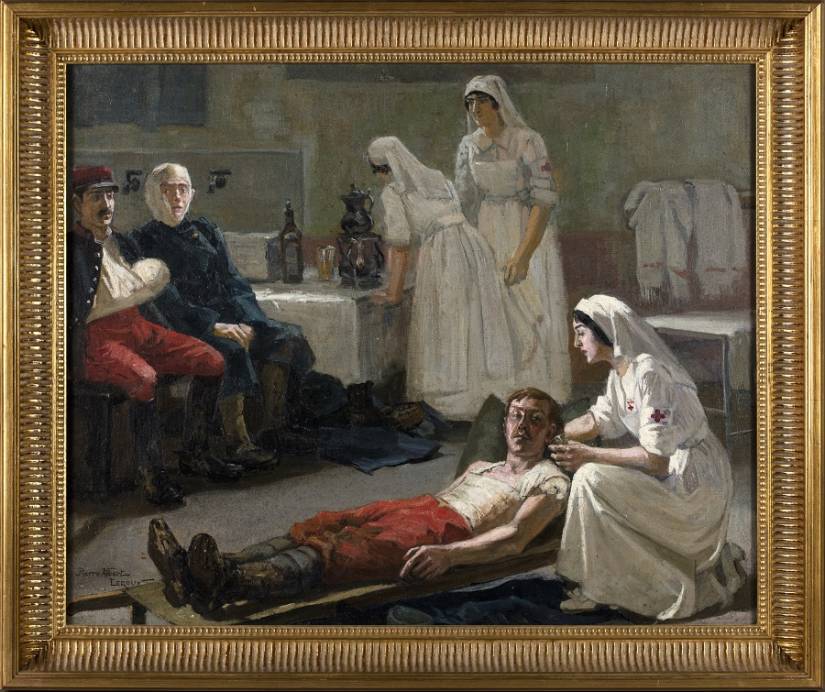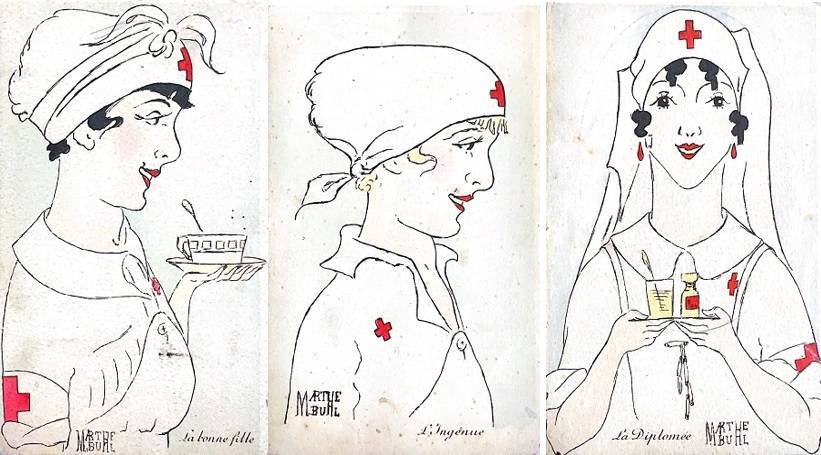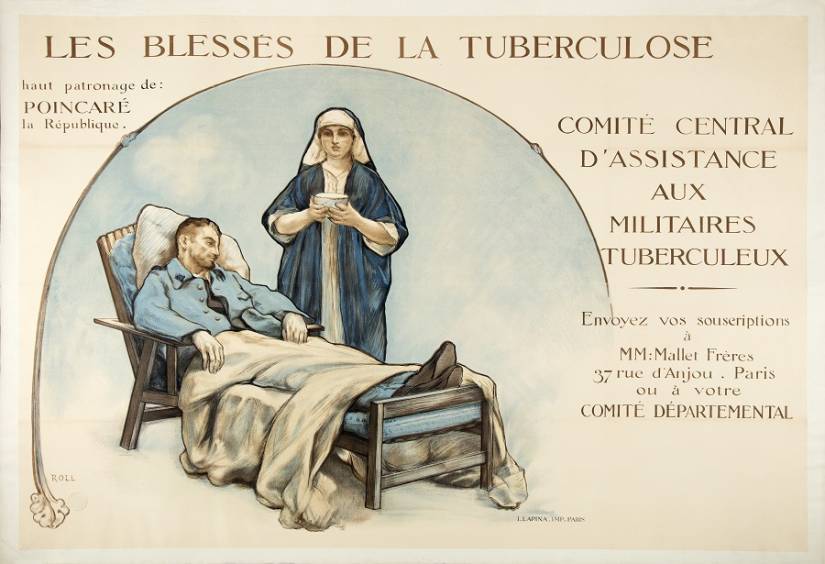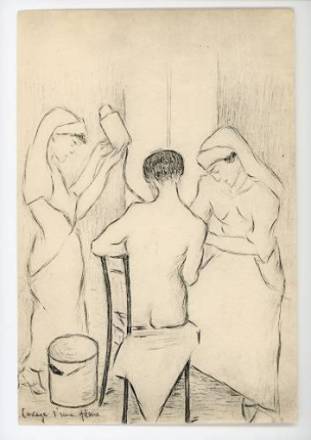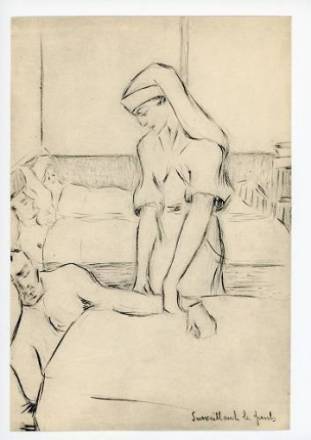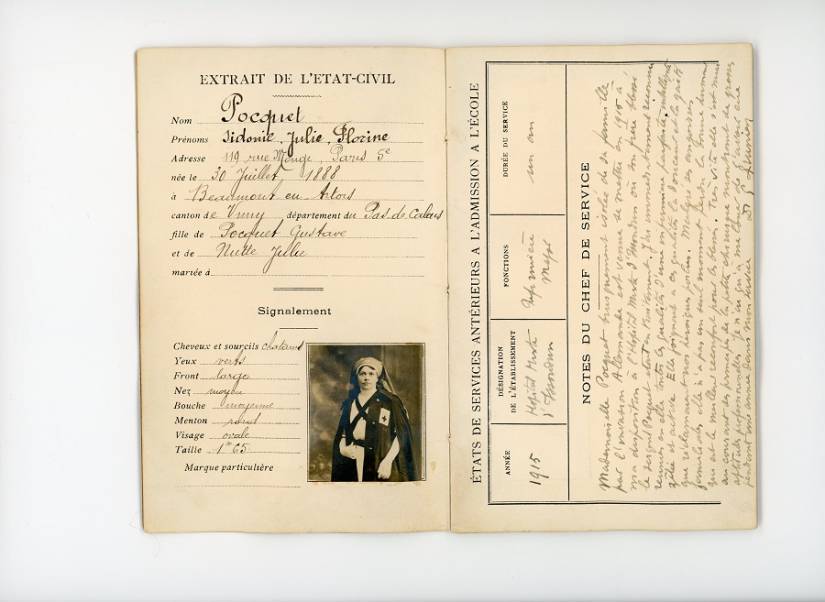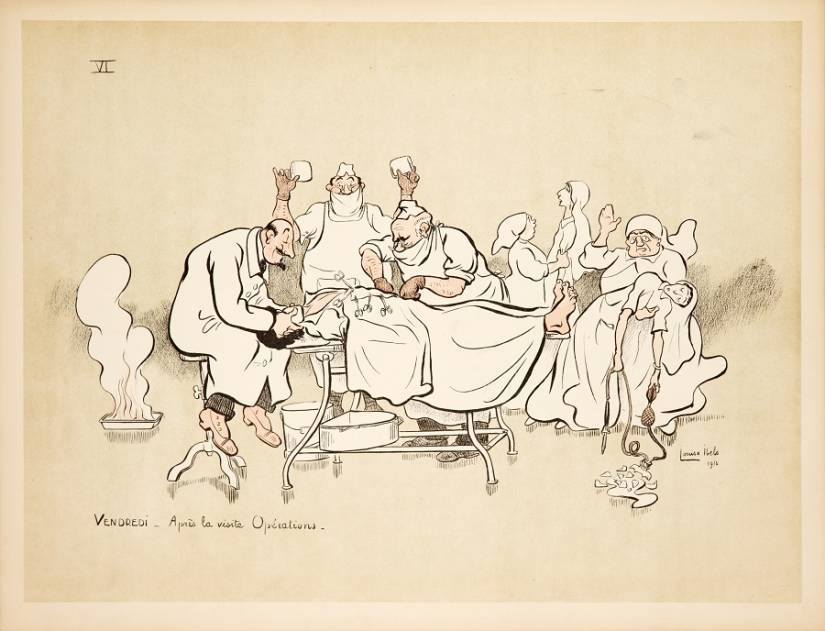Volunteers or salaried, military or civilian, trained or simply dedicated to the care of the wounded, the nurses worked in the service of the victims of war, without really knowing the reality behind the many stereotypes associated with them during the First World War.
the Great War: a major turning point for this profession
Photo, distribution of linen to evacuees from the North © Musée de la Grande Guerre, Meaux
Indeed, the Great War was a major turning point for this profession: the conflict made it possible to advance towards a recognition of this profession, which combines medical knowledge and body knowledge. It is unfortunately the dedication of the nurses if, even if it was real, remained in the memories more than their skills, acquired in contact with the wounded of war.
Nursing outfit for little girl, France, 1915-1918, Wool, cotton and metal sheet © Musée de la Grande Guerre, Meaux – CE2022.4.2-9 / David Rase & Uniforme de l'infirmière Sidonie Pocquet France, ca 1915-1918 © Musée de la Grande Guerre, Meaux / Yannick Marques
Spread over 300 m², the objects and documents that make up this exhibition are mainly from the collections of the Great War Museum. Loans from institutions that are partners in the exhibition as well as from private collectors have also helped to enrich the exhibition’s discourse, which revolves around three main axes:
Photo © Great War Museum, Meaux
- The statutes of nurses during the war, which are very numerous and on which depends their level of qualification and remuneration;
- The nursing practices of nurses who, alongside physicians, make a vital contribution to the care of the injured, and who contribute in an essential way to their recovery;
- The imagery and stereotypes that are associated with nurses during the conflict, and that have been remembered.
Edith Cavell, Elizabeth of Belgium, Sidonie Pocquet...
Throughout the visit, eight portraits of nurses, some known to the general public, and others who remained anonymous, allow the visitor to give names and to associate faces to all the women who contributed to the war effort. Édith Cavell and Élisabeth de Belgique are presented alongside lesser-known women such as Sidonie Pocquet, whose clothes are kept in the museum, as well as objects and documents that belonged to her, such as her nurse’s booklet, her identity card or her diploma.
Photo - In the operating room France, ca 1915-1918, Photograph on glass plate © Great War Museum, Meaux
The scientific council of the exhibition, composed of members of the museum’s team, has also been enriched by the contributions of Virginie Alauzet, head of the French Red Cross’s Records Management Systems and Archives Division, Christophe Debout, IADE, Senior Health Officer, PhD, Educational Manager at the Théodore-Simon Interhospital Training Institute (Neuilly-sur-Marne), Sciences Po/IDM Health Chair UMRS 1145, and Frédéric Pineau, historian specializing in women’s history at the 20the century.
Nurses caring for the wounded, Pierre-Albert Leroux (1890-1959) France, Oil on canvas © Musée de la Grande Guerre, Meaux / David Rase
The exhibition proposes mediation mechanisms to materialize the nurses' working environment during the conflict. They are intended for a family audience, from 10 years. Facsimiles to be manipulated are presented, accompanied by an audiodescription; a booklet presenting the fictional newspaper of Sidonie Pocquet is distributed free of charge to visitors at the reception of the museum; A small questionnaire to test his knowledge is presented at the end of the exhibition. On the other hand, guided tours and conferences will be offered by the museum throughout the duration of the exhibition, so that visitors can deepen the theme. All programming is detailed on www.museedelagrandeguerre.com
The Graduate, the good girl, L’ingenuous Marthe Buhl (1887-1942) France, 1917 Postcard drawn in watercolour © Musée de la Grande Guerre, Meaux – CE2021.13.7; CE2021.13.8; CE2021.13.9
Available in the museum’s shop as well as in specialized bookshops, the exhibition catalogue is rich in contributions from historians as well as specialists in the period and world of health. This catalogue thus presents the history of nurses during the Great War and tells the shattered destinies of many of these women. The book, which has received the support of the Fondation La France mutualiste, reveals how nurses become essential figures in societies at war and is a real tool to understand their sufferings, the difficulties they face and the development of their profession.
The wounded of tuberculosis, Alfred Roll (1846-1919) France, 1916 - Colour lithography on paper © Musée de la Grande Guerre, Meaux – 2006.1.3571 / David Rase
What was your reaction when you learned that the exhibition had received the label "Exhibition of National Interest"?
The entire team was very pleased with this news, which is a fine recognition of the work carried out by the museum since its opening in 2011. We were all the more surprised that our previous exhibition, "Tranchées", also received the label, we did not expect to receive it two years in a row! This label rewards the work carried out by the museum’s conservation department, which contributes to the valorization and dissemination of the museum’s collections. It also highlights the actions put in place by our public service, since mediation is always at the heart of our concerns to enable as many people as possible to be made aware of the history of the Great War through the object.
Gestures of nurses, Sketch 1916-1917, Olga Bing, France, 1916-1917 Prints © Musée de la Grande Guerre, Meaux – Don Verney
Why did you choose to present an exhibition dedicated to nurses?
It is a theme that we knew for a long time that we would propose an exhibition dedicated to it. The museum has many objects and documents that shed light on the role of nurses in the Great War, and we wanted to be able to highlight them. The decision to host this exhibit in 2023 came at a time when there was a lot of talk about the role of caregivers in the fight against Covid-19.
Miss De Gesse, nurse major armed and decorated by her patientsFrance, 1912-1918Paper, gelatin-silver prints © Musée de la Grande Guerre, Meaux – Don Barbez
By dedicating an exhibition to nurses in the Great War, it was possible to draw a parallel between the current situation and the role of these caregivers during another major crisis in contemporary history. The elected representatives of the Communauté d'agglomération du Pays de Meaux have also voted for a special reduced rate (5€ instead of 10€) for nurses who will visit the museum during the duration of the exhibition.
Nurse’s booklet of the Heine-Fould Hospital of the nurse Sidonie Pocquet, France, 1er quarter of the 20e century, Paper © Museum of the Great War, Meaux
What types of collections are presented in this exhibition?
The exhibition features numerous documents that explain and illuminate the status and role of nurses during the Great War, and which will shed light on the stereotypes attached to them. The exhibition also focuses on illuminating photographs, which show the nurses in the situation in daily activities. We also present two sets, one of lithographs and the other of sketches, made by women who were also nurses. The 24 lithographs are the work of Louise Ibels, sister of the nabi painter Henri-Gabriel Ibels, and tell a day in the hospital in a humorous tone and with a great sense of observation of everyday gestures. The other set is a series of 25 sketches by Olga Bing entitled "Gestures of Nurses", which shows the technical gestures made by nurses with great accuracy and realism.
A day in the hospital/ Louise Ibels (1891-1965), France, 1916 - Colour lithographs on paper © Musée de la Grande Guerre, Meaux - CE2022.8.3-21
We also present several objects related to the daily life of nurses, including medical instruments and medals that nurses were decorated with, but also several nursing outfits, including the uniform of nurse Sidonie Pocquet, the holding of the Congregation of the Daughters of Charity of Saint Vincent de Paul (lent by the Archives of the Society of the Daughters of Charity), or the uniform of the nurse Geneviève Hennet de Goutel, lent by the Bugner family, her descendants.
Louise Ibels is from an artist’s family. She learns pictorial techniques with her mother, her half-brother is the Nabi painter Henri-Gabriel Ibels. She practices poetry, drawing or engraving (on wood, aquatint and strong water) and exhibits in several salons. During the war, Louise Ibels illustrates the pages of the newspaper The Bayonet like Élisabeth Branly or Gerda Wegener, other female artists. In this series of 20 prints published in an album entitled "A Day in the Hospital", she tells with a great sense of observation and a lot of humor, the daily life of nurses in an auxiliary hospital.
Olga Bing. What we know about Olga Bing is known to us by the preface of the album written by art critic Louis Vauxcelles: she was a painter before being a nurse in a Parisian hospital. This is confirmed by the precision in the representation of the various technical gestures and care performed by the nurses presented in the 25 sketches of the album "Gestures of nurses". Care, dressings, suction cups, stings or samples, toilets are shown with a desire for realism far from conventional iconography. Published in March 1917, this album was sold to the Brotherhood of Artists.
The wounded of tuberculosis. Tuberculosis is a disease considered shameful because its spread, as well as venereal diseases or alcoholism, is considered favored by social conditions (poverty, unhealthy housing, promiscuity, etc.). Tuberculosis mortality increased in the armies during the war and at the end of 1915, it was proven that the presence of tuberculosis carries a major risk of weakening of the numbers. From then on, the health authorities mobilized to put in place a real anti-tuberculosis armament. Tuberculosis health stations are created to welcome and isolate the sick. The staff are specialized nurses, often less well regarded than those caring for the injured. The title of the poster: The wounded of tuberculosis, recalls that TB patients are also victims of the conflict.
Pierre-Albert Leroux. The nurse continues to inspire the illustrators, artists and authors who stage or celebrate her in numerous iconographic or literary works, in the press or on postcards. The painter Pierre-Albert Leroux uses in this work the classic image of the nurse as a "white angel", devoted and competent whose pure silhouette, haloed of the veil and leaning on the wounded who washes, belly, assists those who suffer, even accompanies the last moments of the one who dies from his wounds.
Nurse outfit for little girl. In the speeches of patriotic mobilization forged for the little girls, the nurse is presented as an example to follow and they must prove worthy of their elders who are in the hospitals. The discourse is relayed on many media of the world of childhood: books and periodicals, games and toys or small sets that take the model of the Red Cross nurse. Thus, little girls are encouraged to care for the wounded through their nurse doll or by dressing up with their outfit. This costume sold at Bon Marché includes apron, blouse and blue cape with a Legion of Honor discount.
Sidonie Pocquet, born in 1888 in Beaumont-en-Artois (Pas-de-Calais), is separated from his family, who remained in the north of France occupied by the enemy. In 1915, she volunteered at the Issoudun Mixed Hospital where her brother was treated for war wounds. She then enrolled in 1916 at the Heine-Fould Hospital in Paris to become a professional nurse. Its outfit consists of a very tight white cotton blouse worn over a blue skirt. It is completed by a white apron with the Red Cross badge embroidered on the chest. On top is worn a long cape made in a dark blue cloth. On the left side of the cape is a white crest embroidered with the letters S.B.M. surmounting a red cross. The three tombac buttons are stamped with a cross bordered with the inscription French Red Cross.
Nurse’s booklet from Heine-Fould Hospital by Nurse Sidonie PocquetAt the end of their training, nurses receive an individual booklet with their photograph and service number. Similar to the soldier’s military booklet, the nurse’s booklet indicates the services performed in times of peace as in times of war, the annual exercises performed in a dispensary-school, internships in hospital departments and the opinions of the doctors who supervise them. On the photograph of her nursing booklet,Sidonie wears her cape held by two bands of sheet of the same shade that cross on the chest. The very practical system keeps the cape on the back of the shoulders while offering greater freedom of movement. She posts a headdress and a white veil embroidered with the Red Cross badge that descends past the shoulders. Usually the nurses' veil is dark blue bordered with white for the city and white.
Miss De Gesse. This photograph is from an album made by Colonel Vignal in memory of one of his men, Second Lieutenant Pierre Clerissy, who died in August 1917. He retraces in photographs the course of the war of Clerissy who was treated at the Gauthier hospital in Marseille from late 1916 to March 1917. In Marseilles, Clerissy rubs shoulders with the nurse-major Mademoiselle de Gesse, whose photograph we discover here, armed and proudly wearing the decorations lent by the wounded of the hospital.
Partager la page
